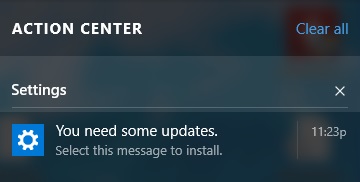
Windows 10 is a solid operating system under the hood, but some poor design decisions have been made at the usability level. The chief among them? Forcing reboots for automatic updates without warning.
As someone who has worked in IT for a long time, I understand the need to keep systems updated, and I approve this effort in principle.
Unfortunately, Windows 10—in particular the Anniversary Update—takes control out of users’ hands, even those who are security conscious. The Anniversary update no longer allows you to easily define update times or schedule reboot times.
Fortunately, there a few ways to take control back.
So, first the obligatory disclaimer. Windows security updates occur for a reason. Operating systems are an incredibly complex combination of programs working together, and vulnerabilities are regularly identified which can open your system to hackers. If you do not keep your system updated after using these tweaks, I’m not responsible for what may happen. 🙂
That out of the way, let’s get to fixing this.
There are two ways to do this, we’ll cover the easy way first.
Windows Registry
If you’re not already familiar, the registry is where settings are stored for Windows itself, as well as many programs you run. The settings for Windows Update are stored there as well, and this allows you to tweak options not normally available through the user interface.

If you’re familiar with Regedit, use the keys above for AUOptions and NoAutoRebootWithLoggedOnUsers as shown in the image above, or pasting the text below into a new .reg file.
Windows Registry Editor Version 5.00 [HKEY_LOCAL_MACHINE\SOFTWARE\Policies\Microsoft\Windows\WindowsUpdate\AU] "AUOptions"=dword:00000002 "NoAutoRebootWithLoggedOnUsers"=dword:00000001
If you’re not familiar with editing the registry, here’s the same thing in a pre-made registry file. Just download this file:
disablewin10autoreboot
Open the zip and double-click to open the file DisableWin10AutoReboot.reg.
Reboot for the changes to take effect.
Group Policy
The other technique is using the group policy editor. Group Policy is used by administrators to control settings in corporate environments, but can also be used on individual machines running Windows 10 Pro.

The image above shows the filtered view, showing only the values that need to be altered.
Computer Configuration>Administrative Templates>Windows Components>Windows Update Configure Automatic Updates: Option 2, with no other options enabled. No auto-restart with logged on users for scheduled automatic updates installations: Enabled
Once you’ve made these changes, reboot for the changes to take effect, or run gpupdate /force from the command line.